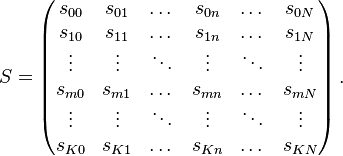Difference between revisions of "Aggregation Matrix"
Wiki admin (talk | contribs) |
Wiki admin (talk | contribs) |
||
| Line 4: | Line 4: | ||
Aggregation can be for example along sectoral or regional dimensions. | Aggregation can be for example along sectoral or regional dimensions. | ||
| − | Vectors and Matrices can be aggregated by multiplying with the aggregation matrix. Mathematically a aggregation matrix | + | Vectors and Matrices can be aggregated by multiplying with the aggregation matrix. Mathematically a aggregation matrix S is a <math>K \times N</math> matrix, where each value <math>s_{mn}</math> is either zero or one. |
:<math>S=\left(\begin{matrix} | :<math>S=\left(\begin{matrix} | ||
| Line 15: | Line 15: | ||
\end{matrix}\right). | \end{matrix}\right). | ||
</math> | </math> | ||
| + | |||
| + | An aggregation matrix with K rows and N columns is used to aggregate a dimension of size N into a smaller dimension of size K. | ||
=== Vector Quantity Aggregation === | === Vector Quantity Aggregation === | ||
| − | A vector of dimension N is aggregated through its pre-multiplication with the aggregation matrix. | + | A vector Y of dimension N is aggregated into a vector K through its pre-multiplication with the aggregation matrix. |
| − | :<math>\mathbf{ | + | :<math> |
| + | \mathbf{Y}^{s} = \mathbf{S} \mathbf{Y} | ||
| + | </math> | ||
| + | |||
| + | or in more explicitly: | ||
| + | |||
| + | :<math> | ||
| + | \mathbf{Y}^{s}_{i} = \sum_{j=1}^{N} \mathbf{S} \mathbf{Y}_j | ||
| + | </math> | ||
=== Matrix Quantity Aggregation === | === Matrix Quantity Aggregation === | ||
Revision as of 17:43, 20 November 2023
Contents
Definition
Aggregation Matrix in the context of Input-Output Analysis is a Boolean Matrix that aims to produce a coarse-grained version of a more granular Input-Output Model.
Aggregation can be for example along sectoral or regional dimensions.
Vectors and Matrices can be aggregated by multiplying with the aggregation matrix. Mathematically a aggregation matrix S is a  matrix, where each value
matrix, where each value  is either zero or one.
is either zero or one.
An aggregation matrix with K rows and N columns is used to aggregate a dimension of size N into a smaller dimension of size K.
Vector Quantity Aggregation
A vector Y of dimension N is aggregated into a vector K through its pre-multiplication with the aggregation matrix.
or in more explicitly:
Matrix Quantity Aggregation
A matrix of dimension N is aggregated through its pre-multiplication with the aggregation matrix and the post-multiplication with the aggregation matrix transpose.



